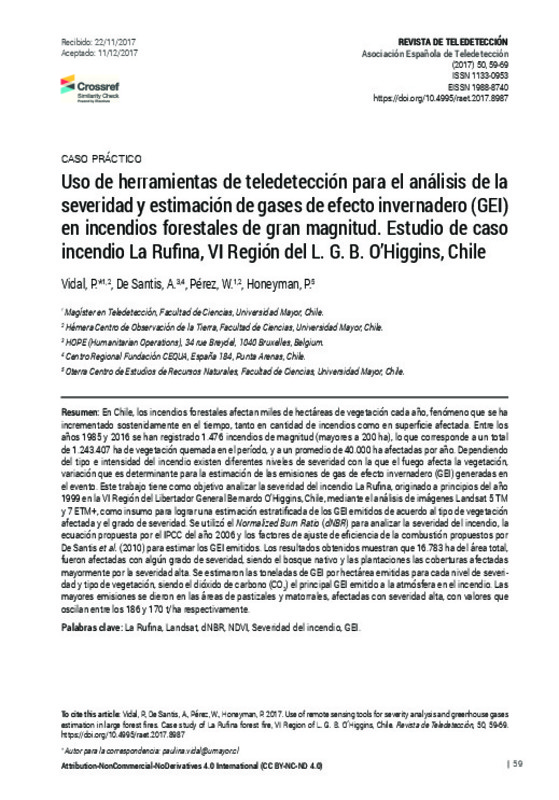

Uso de herramientas de teledetección para el análisis de la severidad y estimación de gases de efecto invernadero (GEI) en incendios forestales de gran magnitud. Estudio de caso incendio La Rufina, VI Región del L. G. B. O’Higgins, Chile
RiuNet: Repositorio Institucional de la Universidad Politécnica de Valencia
JavaScript is disabled for your browser. Some features of this site may not work without it.
Buscar en RiuNet
Listar
Mi cuenta
Estadísticas
Ayuda RiuNet
Admin. UPV
Uso de herramientas de teledetección para el análisis de la severidad y estimación de gases de efecto invernadero (GEI) en incendios forestales de gran magnitud. Estudio de caso incendio La Rufina, VI Región del L. G. B. O’Higgins, Chile
Mostrar el registro completo del ítem
Vidal, P.; De Santis, A.; Pérez, W.; Honeyman, P. (2017). Uso de herramientas de teledetección para el análisis de la severidad y estimación de gases de efecto invernadero (GEI) en incendios forestales de gran magnitud. Estudio de caso incendio La Rufina, VI Región del L. G. B. O’Higgins, Chile. Revista de Teledetección. (50):59-69. https://doi.org/10.4995/raet.2017.8987
Por favor, use este identificador para citar o enlazar este ítem: http://hdl.handle.net/10251/93827
Ficheros en el ítem
Metadatos del ítem
| Título: | Uso de herramientas de teledetección para el análisis de la severidad y estimación de gases de efecto invernadero (GEI) en incendios forestales de gran magnitud. Estudio de caso incendio La Rufina, VI Región del L. G. B. O’Higgins, Chile | |
| Otro titulo: |
|
|
| Autor: | Vidal, P. De Santis, A. Pérez, W. Honeyman, P. | |
| Fecha difusión: |
|
|
| Resumen: |
[EN] Wildfires destroy thousands of hectares of vegetation every year in Chile, a phenomenon that has steadily increased over time, both in terms of the number of fires and the area affected. Since 1985 until 2016 have ...[+]
[ES] En Chile, los incendios forestales afectan miles de hectáreas de vegetación cada año, fenómeno que se ha incrementado sostenidamente en el tiempo, tanto en cantidad de incendios como en superficie afectada. Entre los ...[+]
|
|
| Palabras clave: |
|
|
| Derechos de uso: | Reconocimiento - No comercial - Sin obra derivada (by-nc-nd) | |
| Fuente: |
|
|
| DOI: |
|
|
| Editorial: |
|
|
| Versión del editor: | https://doi.org/10.4995/raet.2017.8987 | |
| Agradecimientos: |
Este artículo se ha realizado en el contexto de fin de grado del Magíster en Teledetección, Facultad de Ciencias de la Universidad Mayor. La autora principal agradece a la Universidad Mayor por la oportunidad de desarrollar ...[+]
|
|
| Tipo: |
|







